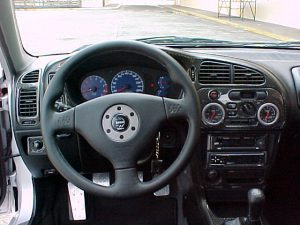Mitsubishi Lancer Evolution V (1998) history and technical infos
Mitsubishi is a relative newcomer to the World Rally Championship but the company has already been extremely successful. It took a lot of enthusiasm and effort to bring the Lancer to its current version, the Evolution VI, the latest and most impressive incarnation of all street legal 4 wheel driven turbocharged cars. The company’s first attempt at the WRC title was incarnated by the Mitsubishi Galant with some success in 1991 and 1992.
The first Lancer to compete in the WRC appeared back in 1993 at the Monte Carlo Rally. It was then driven by Armin Schwarz and Kenneth Eriksson. This first version was soon to be followed by the Evolution II of the Lancer which made its debuts at the 1994 Monte Carlo Rally no longer than a year after the initial version was introduced. The celerity with which the next generation was introduced denotes both the determination of the Japanese company to be as competitive as possible very quickly as well as the seriousness of the involvement of Ralliart the company that is responsible for building the rally cars. Ralliart, an England based company, is run by Andrew Cowan. The Evolution II was driven by Kenneth Eriksson and Isolde Holderied. Next came the famous Lancer Evolution III which debuted at the Corsica Rally in 1995, a year and a half after the introduction of the Evolution II. This version (the evo III) is, to this date, a hard to beat contender in the GroupN class. The evo III was driven by Andrea Aghini at its debut rally.
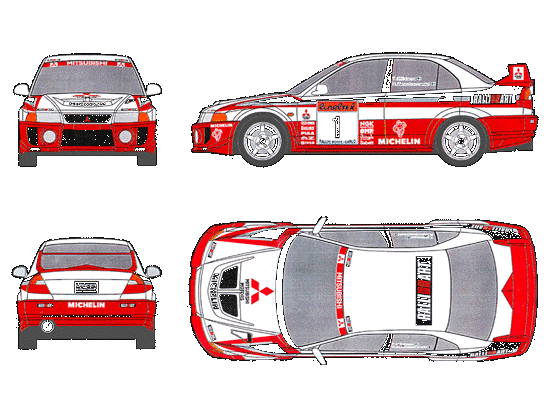
The Mitsubishi Lancer RS Evolution V. Pictures are courtesy of Mitsubishi Motors Corporation in Japan.
By the end of the 1995 season the FIA regulations authorized the WRC class cars to compete. Mitsubishi did not find any particular interest in this formula and continued to produce GroupA rally cars. The company’s reply to WRC cars was the Lancer RS Evolution IV. This was an awesome car that contained some of the most bewildering technology ever to be available on sale on any manufacturer’s catalogue. The evo IV was introduced at the 1997 Monte Carlo Rally, driven by Tommi Mäkinen and Richard Burns.
After running alongside the WRC cars for almost a year and allowing Tommi Mäkinen to be the World Rally Champion, the Lancer Evolution IV was replaced by the Evolution V at the beginning of 1998. By then it was difficult to differentiate the Lancer Evo V from a WRC car. It had the same width as WRC cars had and some of the modifications applied to the Evo IV, in order to produce the evo V, clearly put the evo V in the WRC class. The Lancer Evo V was still a GroupA class car though which means that at least 2500 Evo V had to be produced in order to comply with the FIA rules. This was very good news for rally car amateurs since it meant they could, theoretically, buy a Lancer Evo V. The bad news was that all evo V cars were reserved to the Japanese market and although they could still be purchased from other countries this could only be done through personal import channels. Personal import procedures are very dependent upon the country of import and span from easy to impossible passing from complex and extremely expensive.
For your convenience here’s a brief table resuming the basic specs of the different commercial Lancer Evolution models:
| Lancer Evolution | I | II | III | IV | V | VI | VII |
| Year | 1992 | 1993 | 1995 | 1996 | 1998 | 1999 | 2001 |
| Engine type | 4 inline | 4 inline | 4 inline | 4 inline | 4 inline | 4 inline | 4 inline |
| Displacement (cm3) | 1997 | 1997 | 1997 | 1997.5 | 1998.6 | 1998.6 | 1998.6 |
| Output (bhp @ rpm) | 250 @ 6000 | 260 @ 6000 | 270 @ 6250 | 280 @ 6500 | 280 @ 6500 | 280 @ 6500 | 280 @ 6500 |
| Torque (Kg/m @ rpm) | 31.9 @ 3000 | 31.5 @ 3000 | 31.5 @ 3000 | 36 @ 3000 | 38 @ 3000 | 38 @ 3000 | 39 @ 3500 |
| Tires | 195/55 15 | 205/60 15 | 205/60 15 | 205/50 16 | 225/45 17 | 225/45 17 | 235/45 17 |
| RS weight (Kg) | 1170 | 1180 | 1190 | 1190 | 1260 | 1260 | 1310 |
| GSR weight (Kg) | 1240 | 1250 | 1260 | 1260 | 1360 | 1360 | 1440 |
Of all the successive evolutions of the Lancer the most significant ones were the Evolution IV and evolution V. Introduced in the Evolution IV was an engine rotated by 180°, compared to the Evo III, so that the gear box was relocated on the left side were the driver sits. This positioning offered a better balanced weight distribution. This engine orientation was maintained on the Evo V and later models. The Evo V’s main innovations come from a heavily upgraded engine management system, a relocated and upgraded intercooler, new aerodynamics, upgraded brakes and of course a totally redesigned suspension layout. This last point is, naturally, the most noticeable change in the Lancer. The front and rear tracks where increased by almost 4cm. The Evo V was clearly designed as a tarmac spec car. This fact denotes RalliArt‘s effort to keep up with the WRC class cars. A funny episode of the Evo V’s young career is that the initial prototype which obtained FIA‘s homologation had wheel arches that were too small to fit the 18 inch rims of the rally spec car. Mitsubishi had to obtain the agreement of all the other WRC teams in order to modify this detail.
Click here to compare the Lancer Evolution IV specs to the Evolution V specs.
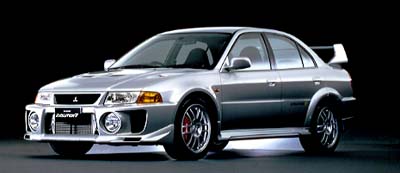
The street version of the Lancer Evolution V.
Picture: Mitsubishi Motors Corporation in Japan
Let’s look now, in more detail, to some of the modifications applied in the evo V when compared to the Evolution IV:
Chassis:
As mentioned earlier the new evolution V was designed, mainly, as a tarmac spec car. Mitsubishi and RalliArt have, however, redesigned many mechanical parts in order to allow changing them very rapidly. This fact proved extremely useful during the evolutions V’s first rallies. The tracks have been widen by almost 4 cm (3.5 cm at the rear). The suspension attachment points have been relocated in order to allow more suspension travel. Suspension travel is still a problem though with only 163mm front and 160mm rear travel in tarmac spec. Bigger brakes have been fitted. The sophisticated, multi-link, rear suspension of the Evolution IV has been maintained. Additional welding points have been applied to the car’s body which provide even more chassis rigidity to an already extremely rigid shell. Note that the new car can very easily be transformed to gravel spec. In this configuration it is, however, a little less agile than the Evolution IV was. Some suspension parts are now made out of aluminum alloy as are the bonnet and front wings!
Transmission:
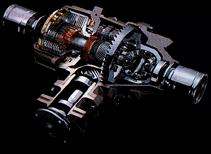
The Lancer’s Evo V rear differential.
Picture : Mitsubishi Motors Corporation in Japan
Not many differences here, mainly detail work. A self-locking front differential has been fitted in the front axle so now all differentials are self locking. The gear box ratios of 3rd, 4th and 5th gear have been shortened. The maximum speed the car reaches now is 180 Km/h. This is clearly a very short final ratio which favors acceleration. Although the Evo V gear box is essentially the same to the one used in the Evo IV all pinions have been reengineered in order to reduce the overall inertia and are now heat treated. The transmission oil circuit holds now a radiator to which is applied a water spray for additional cooling. Finally the mounting points of the rear differential on the chassis have been taken further apart in order to be able to cope with the additional engine torque.
Engine:
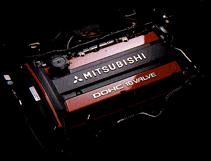
The Lancer’s Evo V engine.
Picture : Mitsubishi Motors Corporation in Japan
Not that many changes here neither. The mechanical parts are essentially the same except for the pistons which were redesigned. The engine’s bore has an additional 0.3mm mainly to improve on piston sealing and blow-by. The compression ratio has been lowered by 0.2 for improved reliability and to allow more turbo boost pressure without causing engine knock. The intake manifold has been shortened, as compared to the one on the Evo IV, in order to improve its gas flow characteristics in high engine speeds. A new, slightly bigger, turbocharger has been fitted (provided by the Japanese manufacturer IHI). The major change in this field is in the engine management system. The new ECU has now double the memory and processing power than the Evolution IV unit had. This allows for far more refined engine management strategies which now take into account many more parameters to calculate the correct fuel quantity and duration of the injection cycle. The new unit proves very useful in the rallying version of the car. A new and huge intercooler has been fitted and relocated just below the front bumper. A water spray projected on the intercooler provides additional cooling.
Aerodynamics:

The Lancer’s Evo V rear wing spoiler.
Picture : Mitsubishi Motors Corporation in Japan
Mitsubishi has taken special care to lower the aerodynamic drag and better the engine bay air flow. There are now two openings on the bonnet. The front bumper is almost non-existent as it is filled with openings and holes everywhere. The lower blade spoiler that was present in the Evolution IV has been dropped. It is replaced by a newly designed lower front bumper. The rear wing spoiler has been completely redesigned and its blade is adjustable in four positions that go from simple to double the down force generated.
Handling:

The Lancer Evolution V engine output graph (the dotted line represents the Evolution IV engine output)
Picture : Mitsubishi Motors Corporation in Japan
The new evolution V of the Lancer is much more neutral than the Evolution IV was. The new transmission, the redesigned drivetrain and the better performing engine management all contribute to lower the understeering character of the previous version. The car now displays a neutral to slightly oversteering handling character.
Overall the new evolution V is a finer version of an already extraordinary car. Its commercial success in Japan is simply huge. Mitsubishi produced, initially, slightly more than 6000 examples of the Evo V and all were instantly sold out. A total of 7500 orders came in and the company okayed the production of 1500 more cars. Unfortunately if you live outside Japan there are little to no chances you’ll ever be able to put your hands on a Lancer evolution V.
The Lancer evolution V, like its predecessor, is commercialized in two versions: the GSR and the RS. The latter is essentially a striped down version of the GSR. It has no airbags, no electric windows, a very spartan interior and a mechanical rear differential. The GSR version features an electronically controlled rear differential, which attempts to reproduce what is available in the competition versions, with little success. The RS version of the car weights 90Kg less than the GSR and is clearly destined to become a GroupN rally car. The conversion shouldn’t be very expensive given the sophistication already built into the base version.
If the street version of the Lancer evolution V is awesome the competition version is simply staggering. Click here for its specs. The front and rear suspension and geometry have been completely revised. The most radical changes, compared to the Evolution IV, occur at the rear suspension. The front suspension transverse wishbones are the same as on the Evo IV but their mounting points on the chassis have been modified. The gear box is the same as the one used on the Evo IV but all its elements have been revised in order to reduce the overall inertia. As before all racing engines are prepared by MMC in Japan. The Evo V racing engines, unlike their commercial counterparts, use a higher compression ratio than the one used on the Evo IV.
The Mitsubishi Lancer Evolution V is currently the only GroupA car to be part of the race for the World Rally Championship title. All its adversaries are WRC class cars. Mitsubishi managed, however, to get the best of both worlds. The Evo V uses the same dimension limits FIA rules will allow for WRC cars, regarding its width for instance, but still takes advantage of the “flexibility” allowed for GroupA cars. Its predecessor allowed Tommi Mäkinen to become the 1997 WRC champion proving Mitsubishi’s choice to stick with GroupA a wise one. The new definition of the Lancer being mainly targeted to tarmac rallying might have been a poorer choice since most WRC rallies are run on gravel or snow. Mitsubishi and Tommi Mäkinen brought proof on the contrary becoming world champions for both the drivers and manufacturers titles in 1998 with the Evolution V in only its first racing season. Further developments of the Lancer on Mitsubishi’s blueprints have produced their next WRC contender, the Lancer Evolution VI, which will still be a GroupA spec car. In the GroupN category the Lancers have been simply unbeatable for the past three years proving the car’s potential beyond doubt.
Click here for Lancer evolution V pictures and here for specs.

